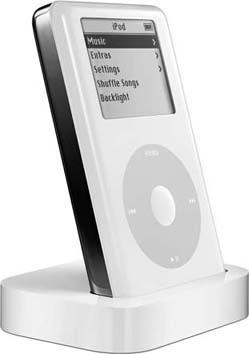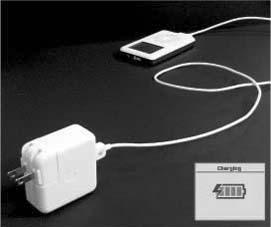Many a cloud of gadget euphoria dies instantly when the new owner realizes that the device must sit in a battery charger and juice up before any fun can happen.
Out of the box, the iPod may have enough juice to turn itself on and get you hooked on spinning the scroll wheel. But you’ll still need to charge the iPod before you use it for the first time.
If your Mac or PC has powered FireWire or USB 2.0 jacks, you can charge up the iPod just by plugging it into your computer. (For FireWire, “powered” usually means the fatter 6-pin FireWire connector, not the little 4-pin connectors found on many Windows machines. For USB 2.0, you need a powered jack like those on the back of the computer, or on a powered USB hub—not, for example, the unpowered jack at the end of a keyboard.) The battery charges as long as the computer is on and not in Sleep mode.
It takes about four hours to fully charge your iPod. Note, however, that it gets about 80 percent charged after 2 hours (Minis only take about an hour to get the 80-percent power rush). If you just can’t wait to unplug it and go racing out to show your friends, you can begin to use it after a couple hours. The iPod Photo, however, takes about five hours to fully charge. It hits the 80-percent powered mark after about three hours of charge time.
During the charging process, you may see either the “Do Not Disconnect” message (if the iPod is also sucking down music from your computer), the “OK to Disconnect” message (if it’s done with that), or the main menu for a few minutes before the charging battery graphic takes over (if it’s a 2003-or-later model). The iPod will also warn you not to disconnect it if you’ve set it up to work as an external hard drive, but we’ll get to that business in Chapter 12.
Some iPods come with a cool accessory: the iPod dock. The dock, shown in Figure 1-4, is a plastic stand with a narrow 30-pin dock connection and stereo lineout jacks built into the back. To charge up the iPod, you can either plug in the flat FireWire or USB 2.0 cable right into the bottom of the player, or plug the cable into the narrow port for it on the back of the dock.
Once the dock is plugged into the computer, place the iPod upright onto the metal connector in the bottom of the dock to begin charging it. The iPod trills out a little tweet of joy when it makes contact, and you see the animated “charging battery” icon.
You can also charge the battery by plugging the iPod’s FireWire cable into the boxy white AC power adapter that comes with it (Figure 1-5). With the iPod turned off, a larger version of the animated charging battery icon appears in the middle of the screen. Because it has the extra luxury of a color screen, the iPod Photo displays a green battery icon. The 2005 Minis don’t include the AC adapter.
Figure 1-4. The iPod dock allows for upright charging and a better view of the iPod’s screen, not to mention a healthy flow of air around that toasty little battery as it charges. If your iPod didn’t come with the dock, you can buy one separately on Apple’s Web site for $40. (Alas, the dock doesn’t fit 2001 or 2002 iPod models. There is one available for the iPod Mini, though.) The dock for the iPod Photo also has an S-video port for tethering your iPod to your TV.
Note
Even when fully charged, the battery in an “off” iPod slowly drains after 14 to 28 days. If, for some inconceivable reason, you haven’t used your iPod in a month or more, you should recharge it, even if you left it fully charged the last time you used it.
Figure 1-5. The FireWire cable that comes with the iPod plugs into the end of the AC power adapter. Flip out the electrical prongs tucked into the adapter’s end, and then plug it into a regular wall socket. Run the FireWire cable between the AC adapter and the iPod’s FireWire port (or charging dock).Inset: The iPod makes it graphically clear that you’re charging its battery–just in case you were wondering. If you have an iPod Photo, you can see this graphic in a soothing green color.
The battery icon on the iPod’s screen shows the approximate amount of gas left in the tank. When the iPod is connected to the computer, the battery icon in the top-right corner displays a charging animation, complete with tiny lightning bolt.
The iPod uses a rechargeable lithium ion battery. Battery life depends on which version of the iPod you have.
If you let a 2001 or 2002 iPod play all night, you can get about 12 hours per charge. But if you’re like most normal people who turn it on and off, tinker with settings, skip around playlists, and turn on the backlight, eight hours is a more likely average.
The 2003-and-later iPod is smaller than the previous models, so it contains a smaller battery; same goes for the iPod Mini. Apple estimates that these models have a battery life of up to eight hours. The 2004 iPods and Minis, on the other hand, have an estimated battery life of 12 to 18 hours, and the iPod Photo promises a whopping 15 hours of play time for music—but only 5 hours if you’re constantly running photo slideshows accompanied by your music. Again, you can expect shorter life in the real world (see the box on page 12 for more details). If your iPod is conking out too soon, contact Apple Support by phone or Web.
Originally, Apple made the iPod without a replaceable battery, at least until it faced a spate of power cells with early deaths (and owner complaints). Apple now offers a $99 battery replacement program and a special AppleCare warranty just for iPods.
Tip
If you don’t mind voiding your iPod’s warranty–or if it’s already expired–and you’re up for a little manual labor, you can pry the case open and replace the battery yourself (page 319).
Get iPod and iTunes: The Missing Manual, Third Edition now with the O’Reilly learning platform.
O’Reilly members experience books, live events, courses curated by job role, and more from O’Reilly and nearly 200 top publishers.



